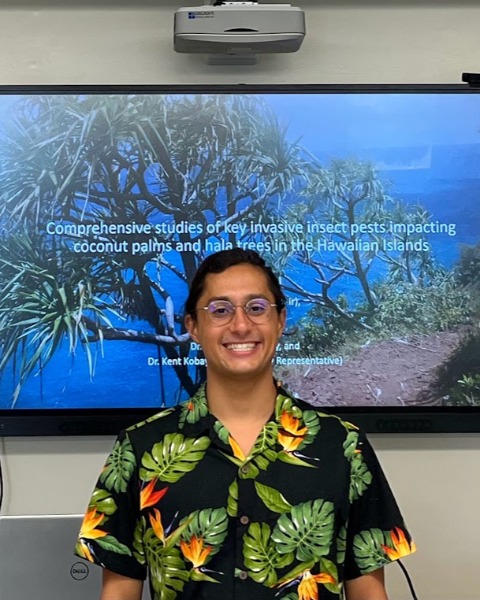Back
Plant-Insect Ecosystems
Student Competition 10-Minute Paper
Grad P-IE: Invasive Species 2
Evaluation of commercial and locally occurring entomopathogenic fungi as a potential tool to control the coconut rhinoceros beetle, Oryctes rhinoceros on Oahu, Hawaii
Monday, November 14, 2022
11:30 AM – 11:42 AM PT
Location: Vancouver Convention Centre, Meeting Room 118

Mason H. Russo
PhD candidate
University of Hawai'i
Honolulu, Hawai'i- ZC
Zhiqiang Cheng
Associate Professor and Extension Specialist
University of Hawaii at Manoa
Honolulu, Hawaii
Presenting Author(s)
Co-Author(s)
The coconut rhinoceros beetle, Oryctes rhinoceros, has re-emerged as a damaging and invasive insect pest of coconut palms and other palm species in Pacific Islands. Its geographic range had expanded during World War Two but was controlled successfully with the release of specimens infected with a Oryctes nudivirus (OrNV). However, beetles resilient to OrNV were found in Guam in 2007, where they have become widespread. As coconut palms and other palm species are integral cultural, economic, agricultural, and ecological plants to many Pacific Islands, the spread of a OrNV resistant biotype has caused a resurgence in research to control this pest. The same resilient biotype found on Guam of Oryctes rhinoceros was found on the Hawaiian Island of Oahu in 2013. There is an extensive eradication program that uses mass trapping, detector dogs, green waste sanitation, breeding site surveys, public outreach, and insecticidal treatments. Our research aimed to evaluate commercial and locally occurring entomopathogenic fungi that could be implemented to control O. rhinoceros. We conducted laboratory and field trials to evaluate the efficacy of BotaniGard ES and several locally collected entomopathogenic fungal strains on 1st instar O. rhinoceros larvae. The laboratory trials indicated that the higher label rate of BotaniGard ES caused statistically significant mortality compared to other treatments and control. The higher label rate resulted in greater than 60% mortality of 1st instar larvae two weeks after treatment. In the field trials the results were similar, with greater than 60% mortality at this rate.


